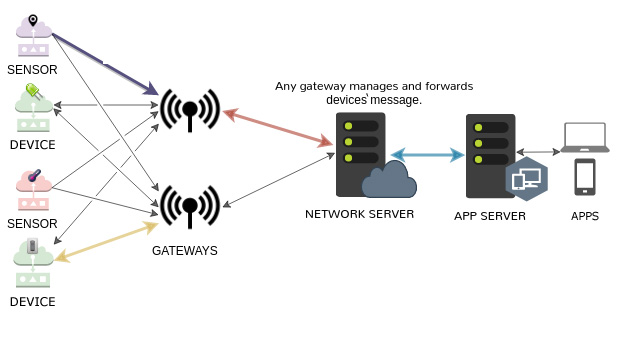Using LoRaWAN for Remote Monitoring
LoRaWAN connects sensors and devices to the Internet-of-Things, often over long distances.
Long Range - 5 to 832 km
LoRaWAN stands for Long Range Wide Area Network. It wirelessly connects battery operated "things" to the internet, using radio frequency bands. For example, in Europe it uses the 863 to 870 MHz band. The stated range is 16 km in a clear line of sight and 5 km in built-up environments. The world distance record, though, is 832 km. This was made with a LoRaWAN sensor attached to a high altitude helium balloon.
Long Battery Life
The system uses very little energy when communicating with sensors. Batteries can last for 10 to 15 years.
Bi-Directional
In default mode (class A), communication is initiated by the end device (such as a sensor). The device can send data at any time. It then leaves a window to receive instructions. This is the lowest power consumption mode. In other modes the network server can also initiate communications. Modes can be switched to save power.
Many Devices from a Single Gateway
It is easy to scale and expand networks. LoRaWAN devices broadcast their messages to a gateway. An 8-channel gateway can handle a few hundred thousand messages a day. So if each device sends a message every 5 minutes, one gateway would support around 350 devices. If each device sent just ten messages a day, their number would go up to around 10 000 devices per gateway. With more gateways, more sensors and devices can be connected. The gateways will accept messages from all sensors within reach.
The gateways forward data to the LoRaWAN network server. These connections can be by Wi-Fi, Ethernet or cellular. In Issue 267 we discussed MQTT. This communication protocol can be used between the gateway and the network server (broker).
The network server or broker makes data available to the user applications, such as pollution monitoring or car counting apps.

LoRaWAN architecture, modified from original image by Brivadeneira, CC by 4.0
Security
Systems are deployed on public or private networks. LoRaWAN uses Advanced Encryption Standard (AES) and 128-bit cryptographic keys and algorithms.
Applications
LoRaWAN is ideal for remote counting due to its low power consumption and long distance communication. For example, Retail Sensing are using it to count illegally parked cars in national parks, providing park authorities with information about numbers of cars every few minutes. It is also a commonly used communication method in smart cities.
Other uses include building automation, health monitoring, farming, pollution monitoring and other data acquisition and control applications.
References and Further Reading
Counting cars in remote national parks
What are LoRa and LoRaWAN?
Learn More
To find out more - or to ask our advice on your project - enter your details below.